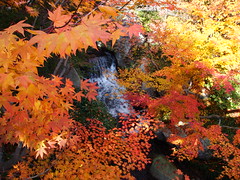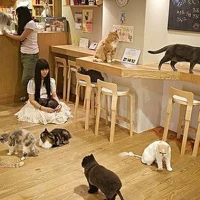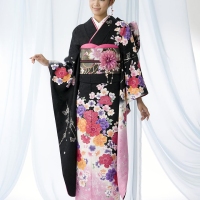‘Embrace the Animal, Strive for the Human’
 You generally know what you’re going to get from a trip to Vanilla Gallery, which specialises in work that flirts with the erotic, sadistic and fetishistic. True to form, this solo show by controversial American artist John Santerineross will feature 58 ‘dark magic’ photographs that delve into Greek mythology, religion and the spiritual world. As the title suggests, the contrast between our animalistic, primitive desires and the notions of compassion, love and understanding that make us human is also explored.
You generally know what you’re going to get from a trip to Vanilla Gallery, which specialises in work that flirts with the erotic, sadistic and fetishistic. True to form, this solo show by controversial American artist John Santerineross will feature 58 ‘dark magic’ photographs that delve into Greek mythology, religion and the spiritual world. As the title suggests, the contrast between our animalistic, primitive desires and the notions of compassion, love and understanding that make us human is also explored.
Details
Open Until Sep 21 Closed Sun
Time Mon-Fri noon-7pm; Sat & hols noon-5pm
Admission ¥500
Address 4F, 6-10-10 Ginza, Chuo-ku, Tokyo
Transport Ginza Station (Ginza, Marunouchi, Hibiya lines)
Stitch Show Launch Exhibition
 Art, design, illustration, handicrafts, and traditional crafts will be on display at Spiral Gallery, in celebration of new book Stitch Show, edited by Junko Yazaki. The launch exhibition will feature a variety of creations and designs by 20 of the craft makers featured in the book.
Art, design, illustration, handicrafts, and traditional crafts will be on display at Spiral Gallery, in celebration of new book Stitch Show, edited by Junko Yazaki. The launch exhibition will feature a variety of creations and designs by 20 of the craft makers featured in the book.Open Sep 10-16
Time 11am-8pm
Admission Free
Venue Spiral
Address Spiral Bldg 1F, 5-6-23 Minami-Aoyama, Minato, Tokyo
Transport Omotesando station (Chiyoda, Ginza, Hanzomon lines), exit B1.
The Fashion
 The work of six fashion photographers – Terry O’Neill, Jeanloup Sieff, Helmut Newton, Willy Maywald, Sheila Metzner and Bettina Rheims – will be on display at this dedicated photo space. The exhibition will include pieces created for commercials and also for the pages of fashion glossies from around the world, with each shot capturing not only the image of the clothing, but also the personality of the model wearing them.
The work of six fashion photographers – Terry O’Neill, Jeanloup Sieff, Helmut Newton, Willy Maywald, Sheila Metzner and Bettina Rheims – will be on display at this dedicated photo space. The exhibition will include pieces created for commercials and also for the pages of fashion glossies from around the world, with each shot capturing not only the image of the clothing, but also the personality of the model wearing them.Details
Open Sep 11-Oct 10
Time 11am-7pm
Venue Ricoh Photo Gallery
Address Ring Cube Building, 5-7-2 Ginza, Chuo-Ku, Tokyo
Transport Ginza Station (Marunouchi, Hibiya, Ginza lines)
Yebisu Beer Festival 2013
 After the summer onslaught of Oktoberfests, here’s an outdoor beer-a-thon that doesn’t feature oompah music, sauerkraut or ludicrously overpriced drinks. It’s held at the sight of a former brewery, and, unsurprisingly, it’ll be strictly Yebisu on tap – if you’re looking for interesting brews, you’d probably be better off heading to the Great Japan Beer Festival 2013 in Yokohama instead. That said, if you get bored of the beer there will be also be a variety of cocktails, iced coffees and snacks to sample in the square.
After the summer onslaught of Oktoberfests, here’s an outdoor beer-a-thon that doesn’t feature oompah music, sauerkraut or ludicrously overpriced drinks. It’s held at the sight of a former brewery, and, unsurprisingly, it’ll be strictly Yebisu on tap – if you’re looking for interesting brews, you’d probably be better off heading to the Great Japan Beer Festival 2013 in Yokohama instead. That said, if you get bored of the beer there will be also be a variety of cocktails, iced coffees and snacks to sample in the square.
Details
Open Sep 11-16
Time Sep 11-12 5-9pm, Sep 13-16 11.30am-9pm (last order 8.30pm)
Venue Yebisu Garden Place
Address 4-20 Ebisu, Shibuya, Tokyo
Transport Ebisu station (JR Yamanote Line), East Exit or (Tokyo Metro Hibiya Line), exit 1
Michael Rother: the music of Neu! and Harmonia
 German musician and Neu! founder Michael Rother will be putting in an appearance at Unit tonight. As the title suggests, the evening will include music from both Neu! and Harmonia, as well as selected solo works, with guest drumming from La Dusseldorf’s Hans Lampe.
German musician and Neu! founder Michael Rother will be putting in an appearance at Unit tonight. As the title suggests, the evening will include music from both Neu! and Harmonia, as well as selected solo works, with guest drumming from La Dusseldorf’s Hans Lampe.Open Sep 12
Time 8pm-11pm
Admission ¥5,500 adv
Venue Unit
Address Za House Bldg, 1-34-17 Ebisu-Nishi, Shibuya-ku, Tokyo
Transport Daikanyama station (Tokyu Toyoko line).
140 Years of Levi’s
 Marking 140 years of the iconic blue jeans, the focus of this exhibition will be the brand’s biggest sellers – the 501s, designed in 1890. There will be a gallery displaying images of 501s from around the world, as well as a photo book for fans to buy.
Marking 140 years of the iconic blue jeans, the focus of this exhibition will be the brand’s biggest sellers – the 501s, designed in 1890. There will be a gallery displaying images of 501s from around the world, as well as a photo book for fans to buy.Details
Open Sep 13-16
Time 11am-9pm (Sep 16 until 6pm)
Venue T-SITE GARDEN GALLERY
Address 16-15 Sarugaku-cho, Shibuya-ku, Tokyo
Transport Daikanyama station (Tokyu Toyoko line).
Hilltop Hotel Beer Garden (2013)
 Ochanomizu’s ‘hotel with personality’ houses its summer beer garden in the same space it uses for wedding ceremonies at the weekend. With pews flanking the long tables, it’s like getting drunk in your school chapel, if your school was actually a Butlins holiday camp. The prices are above average (¥840 beers, party courses from ¥5,800, including food and 90 minutes of all-you-can-drink booze), but there’s little about the setting to warrant paying that much.
Ochanomizu’s ‘hotel with personality’ houses its summer beer garden in the same space it uses for wedding ceremonies at the weekend. With pews flanking the long tables, it’s like getting drunk in your school chapel, if your school was actually a Butlins holiday camp. The prices are above average (¥840 beers, party courses from ¥5,800, including food and 90 minutes of all-you-can-drink booze), but there’s little about the setting to warrant paying that much.Details
Open Until September 13 Closed Sat, Sun & hols
Time Mon-Fri 5pm-9pm
Address 1-1 Kanda-Surugadai, Chiyoda-ku, Tokyo
Transport Ochanomizu station (Chuo, Marunouchi lines), Ochanomizubashi exit.
Intergalactic
 Even if you can’t stand his work with M-Flo (er… guilty), it’s hard not to admire Taku Takahashi’s dancefloor nous. The brains behind web radio station Block.fm also hosts his own party at Womb, propagating a just-don’t-call-it-EDM mix of electro, house, techno, hip hop and all points in between. The latest will feature Yasutaka Nakata, DJ Yummy and the CyberJapan bikini dancers, among others.
Even if you can’t stand his work with M-Flo (er… guilty), it’s hard not to admire Taku Takahashi’s dancefloor nous. The brains behind web radio station Block.fm also hosts his own party at Womb, propagating a just-don’t-call-it-EDM mix of electro, house, techno, hip hop and all points in between. The latest will feature Yasutaka Nakata, DJ Yummy and the CyberJapan bikini dancers, among others.Details
Open Sep 14
Time Doors 11pm
Admission ¥3,500 on the door; ¥3,000 with flyer
Venue Womb
Address 2-16 Maruyamacho, Shibuya-ku, Tokyo
Transport Shibuya Station (Yamanote, Ginza lines), Hachiko exit; (Hanzomon line), exit 3A.
Vietnam Festival 2013
 Some of Yoyogi Park’s nationally themed fests do a better job of staying on message than others. Although the annual Vietnam Festival can always be counted on to supply ample quantities of bánh mì, 333 Beer and pho, its lineup of live entertainment is rather more schizophrenic: last year’s live performers ranged from V-pop singers Phuong Vy and Dan Truong to homegrown Goth-Loli act Die Milch and Queen tribute band Gueen. Er… just take it as it comes. The festival’s 2013 edition marks the 40th anniversary of diplomatic relations between Japan and Vietnam, so you can expect something a little bit special; watch this space for details.
Some of Yoyogi Park’s nationally themed fests do a better job of staying on message than others. Although the annual Vietnam Festival can always be counted on to supply ample quantities of bánh mì, 333 Beer and pho, its lineup of live entertainment is rather more schizophrenic: last year’s live performers ranged from V-pop singers Phuong Vy and Dan Truong to homegrown Goth-Loli act Die Milch and Queen tribute band Gueen. Er… just take it as it comes. The festival’s 2013 edition marks the 40th anniversary of diplomatic relations between Japan and Vietnam, so you can expect something a little bit special; watch this space for details.Open September 14-15
Time 10am-8pm (TBC)
Admission Free
Venue Yoyogi Park
Address 2-1 Yoyogi Kamizounocho, Shibuya-ku, Tokyo
Transport Harajuku Station (Yamanote line), Yoyogi-Koen Station (Chiyoda line), Yoyogi-Hachiman station (Odakyu line)
Body & Soul Live in Tokyo
 Danny Krivit, François K and Joaquin ‘Joe’ Claussell have acquired the aura of elder statesmen on the New York club scene – hardly surprising when you consider that the former two have been rocking the Big Apple’s dancefloors since the 1970s. The trio started their Body & Soul parties in 1996, holding them on Sunday afternoons at the now-defunct Vinyl club in Lower Manhattan. They described the event as ‘like a house party that got too big for someone’s living room’, although you’d have struggled to find a house party that drew such a wide-ranging crowd. While it’s no longer a regular concern, Body & Soul still rears its head from time to time, not least in these annual outdoor parties in Tokyo. Taking place in Harumi Port Terminal, the outdoor Body & Soul Live in Tokyo remains a strictly daytime-only event, starting at 11am and running until 8pm. As ever, visuals come courtesy of New York lighting supremo Ariel.
Danny Krivit, François K and Joaquin ‘Joe’ Claussell have acquired the aura of elder statesmen on the New York club scene – hardly surprising when you consider that the former two have been rocking the Big Apple’s dancefloors since the 1970s. The trio started their Body & Soul parties in 1996, holding them on Sunday afternoons at the now-defunct Vinyl club in Lower Manhattan. They described the event as ‘like a house party that got too big for someone’s living room’, although you’d have struggled to find a house party that drew such a wide-ranging crowd. While it’s no longer a regular concern, Body & Soul still rears its head from time to time, not least in these annual outdoor parties in Tokyo. Taking place in Harumi Port Terminal, the outdoor Body & Soul Live in Tokyo remains a strictly daytime-only event, starting at 11am and running until 8pm. As ever, visuals come courtesy of New York lighting supremo Ariel.Details
Open Sep 14
Time Doors 10.30am
Admission ¥6,000 on the door; ¥5,000 adv
Venue Harumi Port Terminal
Address 5-7-1 Harumi, Chuo-ku, Tokyo
Transport Katsudoki Station (Oedo line), Shin-Toyosu Station (Yurikamome line)
Market of the Sun
 Japan’s largest regular urban farmer’s is kicking off this month, and will feature more than 100 vendors from around the country. In addition to a vast range (more than 50 types) of Western and local vegetables, such as baba eggplant and sanjaku cucumber, each month the market will feature a different seasonal fruit or vegetable. For the first market in September, tomatoes will be the chosen ones, and vendors will sell around 50 varieties from around the globe – including heirloom tomatoes and black cherry tomatoes. Farmers will also hold workshops and let visitors get involved with harvesting, making it a great option for parents hoping to sneakily educate their kids.
Japan’s largest regular urban farmer’s is kicking off this month, and will feature more than 100 vendors from around the country. In addition to a vast range (more than 50 types) of Western and local vegetables, such as baba eggplant and sanjaku cucumber, each month the market will feature a different seasonal fruit or vegetable. For the first market in September, tomatoes will be the chosen ones, and vendors will sell around 50 varieties from around the globe – including heirloom tomatoes and black cherry tomatoes. Farmers will also hold workshops and let visitors get involved with harvesting, making it a great option for parents hoping to sneakily educate their kids.After September, the market will be held on the second Saturday and Sunday of each month.
Details
Open Sep 14-15
Time 10am-5pm
Address 1-11-14 Kachidoki, Chuo-ku, Tokyo
Transport Kachidoki Station (Toei Oedo Line, exits A4a, A4b)
JATA Travel Showcase 2013
 This annual trade fair of all things travel related is one of the biggest in Asia, featuring more than 1,000 booths representing over 150 potential destinations. This year’s theme is ‘Energy in Japan’, and there will be plenty of hands-on activities for visitors to get involved in, and plenty of opportunities for souvenir shopping.
This annual trade fair of all things travel related is one of the biggest in Asia, featuring more than 1,000 booths representing over 150 potential destinations. This year’s theme is ‘Energy in Japan’, and there will be plenty of hands-on activities for visitors to get involved in, and plenty of opportunities for souvenir shopping.Details
Open Sep 14-15
Time Sat 10am-6pm, Sun 10am-5pm
Venue Tokyo Big Sight
Address 3-11-1 Ariake, Koto, Tokyo
Transport Kokusaitenjijo Station (JR Rinkai Line) or Kokusai-tenjijo-seimon station (Yurikamome Line)




















































